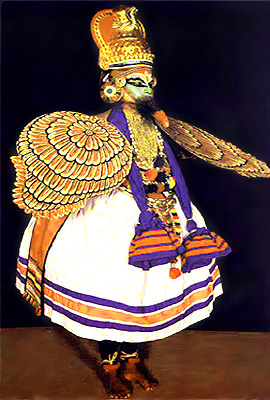 Costume and make up in Krishnattam form the basic part as it makes the act more effective. The costumes are made by the teachers and artists themselves. There is a basic difference between male and female costumes.
Costume and make up in Krishnattam form the basic part as it makes the act more effective. The costumes are made by the teachers and artists themselves. There is a basic difference between male and female costumes.
The dress of male characters comprises of:
•A stiff gathered petticoat.
•A gathered white skirt with orange and black horizontal stripes towards the bottom.
•Bells attached to leather pads in order to tie below the knees.
•A long-sleeved shirt, open at the back that is secured by ties.
•A breast-plate
•Chest ornaments made of beads and fresh flowers
•A girdle
•Upper arm and wrist ornaments
•One shawl or more with a mirror that is attached at each end
•Ear and forehead ornaments and
•A headdress.
The characters who are dressed in the above mentioned basic costumes distinguish themselves by several means: colour and design of make-up and mark, design of headdress and weapon or any other stage property.
The costumes of the female characters include:
•A long white gathered skirt with red border
•A long sleeved blouse, open in the back and secured by ties
•A girdle
•Ornaments for the arm
•A wooden breast plate with the breasts covered in red cloth and with ornamentation above and below it.
•Beads
•Ear and forehead jewelleries.
•The dancer ties onto his head an item that is made of cotton covered with black cloth. This resembles hair wrapped in a bun. Over this bun a piece of cloth is draped that is secured at the forehead with an ornament leaving the remaining cloth to fall over the shoulders and down the back. Female characters tie strings of bells around their ankles which is called chilanka.
The actors use three to four colours for basic make-up: pazhuppu, an orange with more red than yellow, minukku, an orange with more of yellow than red, Paccha, a particular green shade which has more yellow than blue. For blue they use powder blue, for yellow manayola is used, for red chhaillyam and cencillyam is used. Black and white colours are also used. The chutti artist applies a chutti if he has to wear it. The chutti has two white borders which are extended from ear to ear along the jaw and chin line. The `pachha` makeup is done on the main characters like `Vasudeva,` ` Kamsa,` `Nandagopa,` `Uddhava,` `Krishna,` `Arjuna,` `Jarasandha,` and `Sisupala.` The `kathi` make-up is done on evil characters. The pazhuppu make-up is done on Balarama, Bhima and Lord Shiva. The female characters don the `minukku` makeup. The pachha, kathi makeup style along with the main female characters wear the `chutti`.
After make up, the process of costuming starts. Below the knees the Chilanka is tied. Thereafter, he wears a cotton underskirt. In preparing the underskirt, two people hold taut, a long piece of quilted material. The actor and the helper together wrap the gathered under slip around his waist and secures it. They wrap the white stripped skirt in the same manner. On each side they place a six-to-eight inch wide panel of material that is trimmed with brocade over the top of the skirt. The upper end of the panel is tucked into the waist band of the underskirt.
In the next stage, the actor puts on long-sleeved shirt which is open at the back as well as fastened with ties. A breast plate is added to this shirt, chest decorations of necklaces and garlands are also added. Again depending on the character one or more long shawls with a mirror at each end and arm ornaments are also used. This mirror is used by the actor to check his make-up throughout the performance. Now finally, his hand is wrapped in a black cloth, wears the ear and forehead ornaments and prays to Lord Vishnu silently.
Head gear is the most sacred part of the Krishnattam costume. Mudi and kiridam are two basic kinds of head dress. There are two types of mudi as well as Kiridam also. The costumes and make in Krishnattam are elaborate and require time and patience to be worn.




